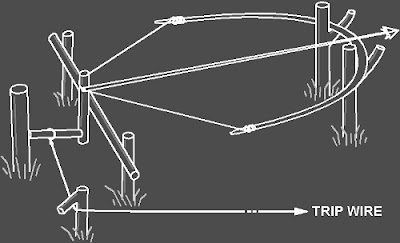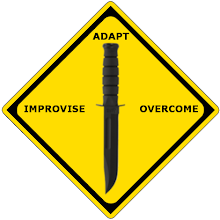Survival Bow Trap
- A survival bow trap is dangerous to man as well as animals, use and construct with extreme caution!
- To construct this trap, build a bow and anchor it to the ground with pegs.
- Adjust the aiming point as you anchor the bow. Lash a toggle stick to the trigger stick.
- Two upright sticks driven into the ground hold the trigger stick in place at a point where the toggle stick will engage the pulled bow string.
- Place a catch stick between the toggle stick and a stake driven into the ground.
- Tie a trip wire or cordage to the catch stick and route it around stakes and across the game trail where you tie it off.
- When the prey trips the trip wire, the bow will fire an arrow into it.
- A notch in the bow serves to help aim the arrow.

In this video I will be showing you how to make a Bow Trap hope you like it
a bow trap
Labels: Bushcraft, Food Procurement, Survival, Survival Bow Trap
Some thoughts on Bushcraft as part of your skills base of being more self-reliant
SHTF Scenarios Survival Situations and Action Priorities
0 comments Posted by Bushcraft and Survival SkillsAny SHTF Scenario or survival situation will have unique aspects that alter the order in which tasks need to be accomplished. It is useful to think in blocks of time.
Example:
The first 24 hours are crucial in any survival situation. You must make an initial assessment of your situation. Hostiles, weather, terrain, remaining daylight, and available resources will determine which tasks you need to accomplished first.
They should be the following:
- Shelter
- Fire
- Water
- Signaling
After the first 24 hours have passed, you will now know if you can survive. This time period needs to be spent on expanding your knowledge of the area.
By taking the following actions, you will be able to gain valuable knowledge.
- Tools and weapons.
By scouting a short distance from your shelter to locate the necessary resources, look for water, edible food sources, and game trails.
- Traps and snares.
As you move further away from your shelter to set traps and snares, you will be able to locate your shelter area from various vantage points. This will enable you to identify likely avenues of approach into your shelter area.
- OPSEC ( Operational Security )
Knowing the likely avenues of approaches of both man and animal, you can effectively place noise and casualty producing path guards to ensure the security of your shelter area.
For the remainder of your survival situation. This time is spent on continuously improving your survival situation until you are rescued.
Labels: SHTF Scenario, Survival, Survival Situations
Survival Situations & Natural Reactions.
We as humans have been able to survive many changes in our environment throughout the ages. This inherent and innate ability enables us to adapt both mentally and physically to a constantly changing world that keeps us alive. The average person will have some psychological reactions in a Survival Situation or SHTF Scenario.
Listed here are possible major visceral reactions and emotions you might experience within a Survival Situation or SHTF Scenario:
- FEAR. Fear, also known as "Fight or Flight Response", is one possible emotional reaction to a dangerous situation that we believe may have the potential to cause injury, illness or even death. Fear can have a positive effect, as it has the ability to heighten our senses and force us to be more cautious in situations where reckless actions could result in injury.
- ANXIETY. Anxiety is an uneasy, apprehensive feeling of impending doom we get when faced with potentially dangerous situations. A survivor will reduce his or her anxiety by keeping focused on tasks that will ensure their coming through the SHTF ordeal alive.
- ANGER & FRUSTRATION. Frustration arises when a person feels he or she is continually thwarted in his or her attempts to reach a goal. One result of frustration is anger. Possible causes could be, getting lost, breaking or losing equipment, bad weather, inhospitable terrain, or even your own physical limitations are just a few. Frustration and anger can lead to impulsive reactions, irrational behavior, bad decisions, and in some cases, an "I quit" or "I give up" attitude.
- DEPRESSION Depression is close cousin with frustration and anger when faced with the hardships of survival situations or you find that everything is FUBAR. This can lead to a destructive cycle between anger and frustration, and can continue until the person becomes worn down-physically, mentally and emotionally. At this point, he or she starts to give up, and his focus shifts from "What can I do" to "There is nothing I can do." Which if left unchecked, will ultimately lead to your untimely death.
- LONELINESS & BOREDOM Man is, by nature, a social animal and enjoys the company of others. Loneliness and boredom can be another source of depression. For one to survive, you must find ways to keep your mind productively occupied.
- GUILT Whatever circumstances have lead you to your survival situation can sometimes be dramatic or even tragic. It could have been the result of a horrific accident, or some other SHTF scenario, where there was a loss of life. Perhaps you were the sole survivor, or one of a few, survivors left. While naturally relieved to be alive, you might find yourself to be simultaneously mourning the deaths of others who were not as fortunate. If you are to survive, then it is imperative to muster the strength to carry on. Do not let feelings of guilt prevent you from living.
Labels: FUBAR, SHTF, SHTF Scenario, Survival, Survival Situations


 Subscribe
Subscribe